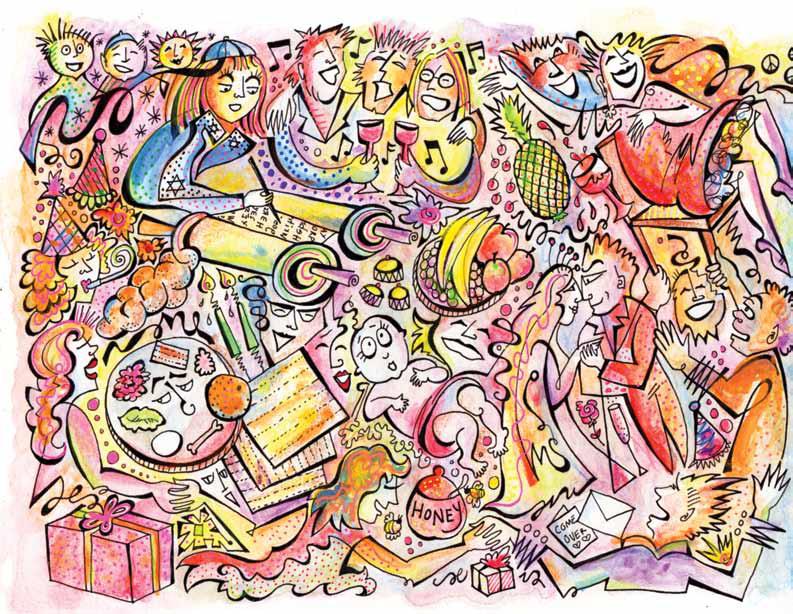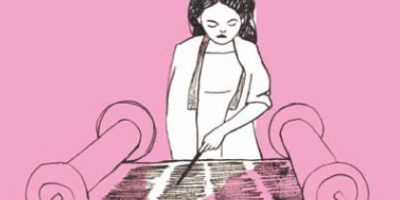
What We Invite to Our Bat Mitzvahs
The other day I drank 2 cups of coffee in the morning, and then another around 4 PM; I’m almost 45, so it came as no surprise that I was wide awake, almost impossibly so, at 3 PM. I decided that this would be a prefect time to watch Adam Sandler’s new film “You Are So Not Invited to My Bat Mitzvah.”
Everyone had seen it but me; I had missed out on a cultural moment. So I
loaded Netflix on my phone and got to thinking about bat mitzvahs. There’s been a lot of talk about bat mitzvahs of late.
Early 2022 saw the 100th anniversary of Judith Kaplan’s bat mitzvah, the first ever held in North America, which led to a slew of thought pieces about a centenary of feminist Judaism and its legacies. And then there were a series of b’nei mitzvah refusals on mainstream TV, including on And Just Like That, when
non-binary Rock refused to participate in their They Mitzvah, trans actress Hari Nef as Rabbi Jen, and Charlotte beautifully leyned the parshah (Torah portion). Rock’s refusal was notably coupled with another mediated Bat Mitzvah refusal in Fleishman is in Trouble, when Hannah Fleishman articulates why the ceremony means nothing to her. And her father concedes and offers her the priestly blessing. Rock and Hannah are urban, complicated kids growing up in cosmopolitan settings, and are given the space to refuse.
Sandler’s film takes a different tack, representing a suburban, wealthy, Jewish community, where a bat mitzvah is imagined from childhood. Here, the parties are spectacular and expensive and invoke a whole industry created around celebrating this one night (hail DJ Shmulick). Making it relevant and relatable is queerish Rabbi Rebecca, and a ton of Jewish kids with multiracial identities and interfaith families.
The film is about friendship and kindness; its climax of sees protagonist Stacy Friedman finally become a mensch after months of treating people badly; what could be a better step into adulthood? And… she finally learned her parshah.
This latter part got me thinking about my bat mitzvah and what it meant and continues to mean to me, some 32 years later. I celebrated it in August 1991, Parshat Ki Tavo. As I type these words, the first lines of my Torah portion come to mind. I could not tell you what my project or speech were about, but I do remember learning the niggunim (chants) and how to read the Torah without otiyot (vowels) over the preceding year. I had the advantage of fairly fluent Hebrew, and my dad taught me the melodies he’d learned for his bar mitzvah in 1963. He showed me how to find the little line in the printed Tanach where the niggun emphasized a word, breaking up a sentence into some- thing chantable. I remember afternoons in the company of a very old man, the late Cantor Manny Bach, who helped me fine-tune the reading; I hope I expressed that I was grateful.
I was brought up in the Reconstructionist tradition, so my learning load was the same as any bar mitzvah boy—I learned to leyn all the aliyot, along with the haftarah. What was less expected was what I did in the lead up; at some point it was decided that we would hold a Thursday morning minyan where I would put on tefillin for the first time. While our synagogue was used to women and girls reading Torah, a 12-year old girl in tefillin was unsettling. Considering it now, I’m proud of my dad and rabbi for pushing the community to confront its limits around gender roles. My bat mitzvah is the closest I’ve come to doing something perfectly. My dad set a high standard for what he expected from me on the bimah that morning and framed it as my responsibility to my community to achieve it. I practiced, more than I have practiced anything, and took pride in not having made many mistakes. I have never managed to do anything with the confidence and mastery I had when delivering my bat mitzvah portion. In retrospect, maybe that’s sad. But I think it’s also wonderful to have been taken seriously, handed a challenge and escorted down the path towards meeting it.
It was also such a tangible and rare skill to acquire; in the years that followed, I chanted Torah regularly, eventually learning the special niggunim for the high holidays and for Megillat Esther at Purim. I even became a pinch-hitter in my community. Under the tutelage of a feminist educator at my Jewish high school, we held a monthly Torah service for the girls at the adjacent elementary school; their Orthodox teachers would sometimes yell at us for doing something inappropriate, reserved only for men.
I was also a 12-year old, and I relished the gold necklaces and bracelets I received, the leather knapsack I was gifted by a family friend. I loved the outfit I wore to the party, my the Nineties hair blowout. Though the details are hazy, pictures show me that my extended family travelled from all over North America to be there to celebrate with me.
I went shopping for a tallit the summer before my bat mitzvah at Kolbo, a Judaica store in Brookline, Massachusetts. My parents asked me if the one I picked would be one I’d want to wear as an adult (it was shiny and purple). The truth is, I don’t think any of us imagined I’d grow up into an adult who doesn’t wear one. But the last time I was on the bimah was Rosh Hashanah 2002, a couple of days before leaving to go start my Ph.D.
As the Jewish parent in a multiracial and interfaith family, I’ve worked hard to frame a Jewish identity for my kids rooted in tolerance, critique, and joyfulness; we celebrate every holiday with a big family dinner, and the boys go to shul occasionally with their Bubbe and Zayde. We talk about tikkun olam (repairing the world), about our family’s survival of the Holocaust, and more. But we’re a little low on Hebrew skills, and I have yet to give much thought to what we might do to mark their becoming b’nai mitzvah, keepers of their own responsibility for the doing of mitzvot.
Like Adam Sandler’s Stacy Friedman, I hope it’ll involve something menschy; which is to say, a step forward into adulthood and community. I know that I will offer them my blessing.
Dr. Rachel Berger teaches at Concordia University. She was a part of Lilith magazine’s 2023 “The New 40” cohort for feminist writers over 40.
Art by Flash Rosenberg



